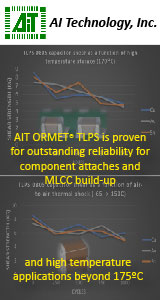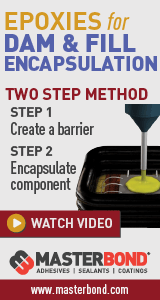|

|
|
| Ask the Experts | |||||||
|
|||||||
|
August 7, 2018 - Updated April 25, 2011 - Originally Posted Delay Before Washing Water Soluble Flux
J. C. |
|||||||
| Expert Panel Responses | |||||||
|
Water-soluble fluxes have high percentage of organic activators and are generally corrosive in nature. For this reason, it's always recommended to clean these fluxes immediately. If not, there is always the risk of acidic activators etching the solder joints that could result in corrosion and electrochemical migration. In order to avoid any failures, it's always recommended to clean these OA fluxes as soon as possible preferably within 1 hour of soldering. In your case, we have ensure the fluxes are removed completely. Once you have the remaining parts, perhaps you might need to re-clean the boards. If you prefer to leave the partial assemblies having fluxes for 3-4 days, there is a high likelihood that you might need aggressive wash process settings and/or even making use of low concentration chemistry that would assist in successfully removing the residues under low stand-off components.
Application Technology Manager Zestron America Mr. Tosun has published numerous technical articles. As an active member of the SMTA and IPC organizations, Mr. Tosun has presented a variety of papers and studies on topics such as "Lead-Free Cleaning" and "Climatic Reliability".
This is a difficult question to answer, without knowing the chemical makeup of the flux. Oxidation-reduction and/or acid/base chemistry can occur at room temperature over long periods of time. These events occur very quickly at higher temperatures which result in cleaning the metal oxides from the metallic surfaces. One of the questions I would ask is "does the desired cleaning/wetting effect occur at room temperature by the same path as it does at higher temperatures, or is the 'colder' but longer chemistry different (presumably with different results)? The reason for the vague answer is that all too often we see differences between results from accelerated test results compared to those from longer term test results, for any number of phenomena. At higher temperatures, chemical pathways can oftentimes be different than at lower temperatures. Other effects which may influence the long term result will be the effects of solvents (within the flux) on the board/component materials. Will long term exposure of board or component surfaces in contact with high boiling solvents change anything? I don't know. These would be my immediate concerns/questions.
Chairman Polyonics, Inc. Jim Willimas is a PhD Chemist in Polymers and Materials Science. He specialize in printing, cleaning, inks, and coatings used in electronics manufacturng operations. Williams has more than 30 years experience.
The residues from most water soluble fluxes should be removed as promptly as possible since they may begin to cause surface corrosion. This is very dependant on the supplier and type and I would recommend you contact your supplier on the subject. If I had to make a decision I would wash these with shortages and then re-wash when the assemblies are complete.
Principal Engineer - CMA Lab BAE Systems Bryan Kerr has 35 years experience in providing technical support to PEC assembly manufacturing. His experience ranges from analysis of materials and components to troubleshooting and optimizing, selecting reflow, cleaning, coating and other associated processes.
This depends on the type of water soluble flux that you used. If you are talking about a wave solder flux then I would think that you would be OK assuming you are using a neutral pH flux. If you are using an acidic based flux then I wouldn't recommend it. Check with the manufacturer of the flux. As for solder paste that is water soluble, I know that FCT Assemblies do not have an issue with cleanliness after delayed rinsing for this time period.
President FCT Assembly Mike Scimeca created FCT Assembly after the purchase of Fine Line Stencil, Inc., and consists of two major operations: stencil manufacturing and the manufacturing of electronic assembly products such as solder paste, flux and solder bar.
Not all water soluble fluxes are equally safe when left in place for extended periods before cleaning. You should contact your solder paste supplier to find out what the limits are for your solder paste.
Application Engineering Supervisor Nordson EFD Mr. Vivari has more than 15 years of electronic engineering design and assembly experience. His expertise in fluid dispensing and solder paste technology assists others in identifying the most cost effective method for assembling products.
The answer is really about what type of Water Soluble Flux you are using. Some that are not H1 or H0 activated will be fine to leave on the Boards. But those which are H1 or H0 activated according to Jstd004 I would recommend to clean them between soldering.
Technical Sales Manager BLT Circuit Services Ltd Greg York has over thirty two years of service in Electronics industry. York has installed over 600 Lead Free Lines in Europe with Solder and flux systems as well as Technical Support on SMT lines and trouble shooting.
A common answer in this industry, "...it depends". There has already been several fine reasons submitted for or against this practice of when to wash. Over my 29 + years in this industry I have seen too many horror stories associated with miss-application of OA fluxes. Details are thin as to the exact type of your water soluble flux so if I was in your position I would wash them as soon as recommended by the flux manufacturer. Washing your boards twice will be less painful then having to confront the potential of corrosion or some other issue that may arise once the board gets in the field.
Technical Expert Sales Support Kyzen Corporation Charlie Pitarys has over thirty years of industry experience and has been with KYZEN for twenty-one years. Charlie is a former Marine and a retired Sargent First Class in the Army Reserves. His previous employers include Hollis and Electrovert. Charlie continues to use his expertise on cleaning processes and machine mechanics to help KYZEN customers and partners improve their cleaning operations.
|
|||||||
| Submit A Comment | |||||||
|
Comments are reviewed prior to posting. You must include your full name to have your comments posted. We will not post your email address. |
|
Free Newsletter Subscription
Circuitnet is built for professionals who bear the responsibility of looking ahead, imagining the future, and preparing for it. Insert Your Email Address |
|

|








